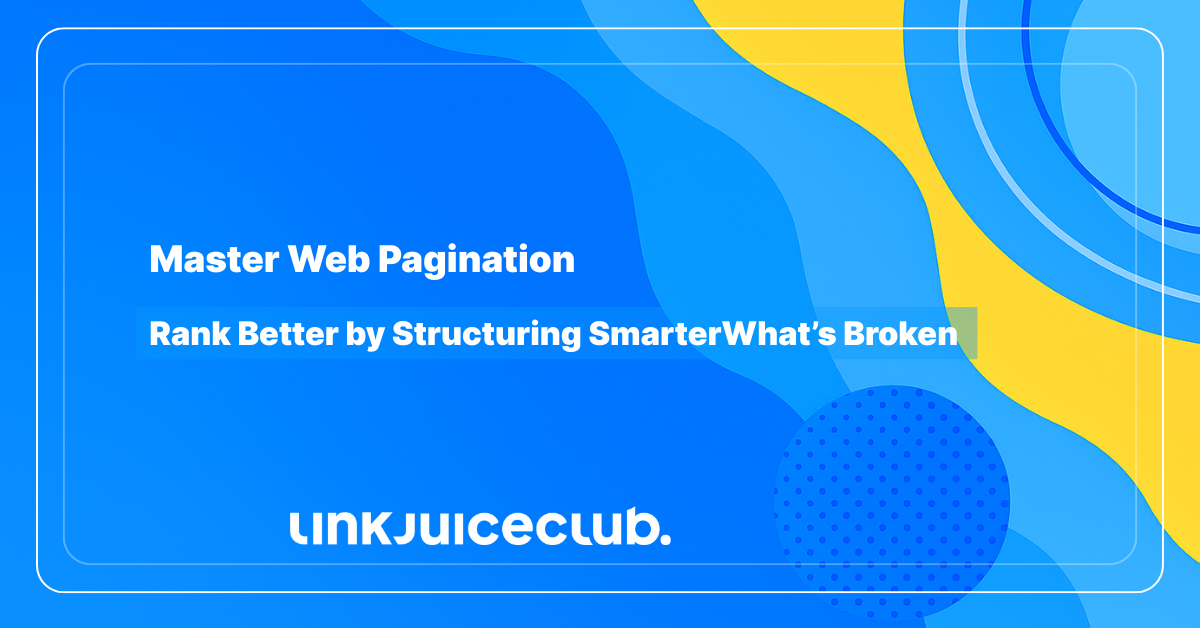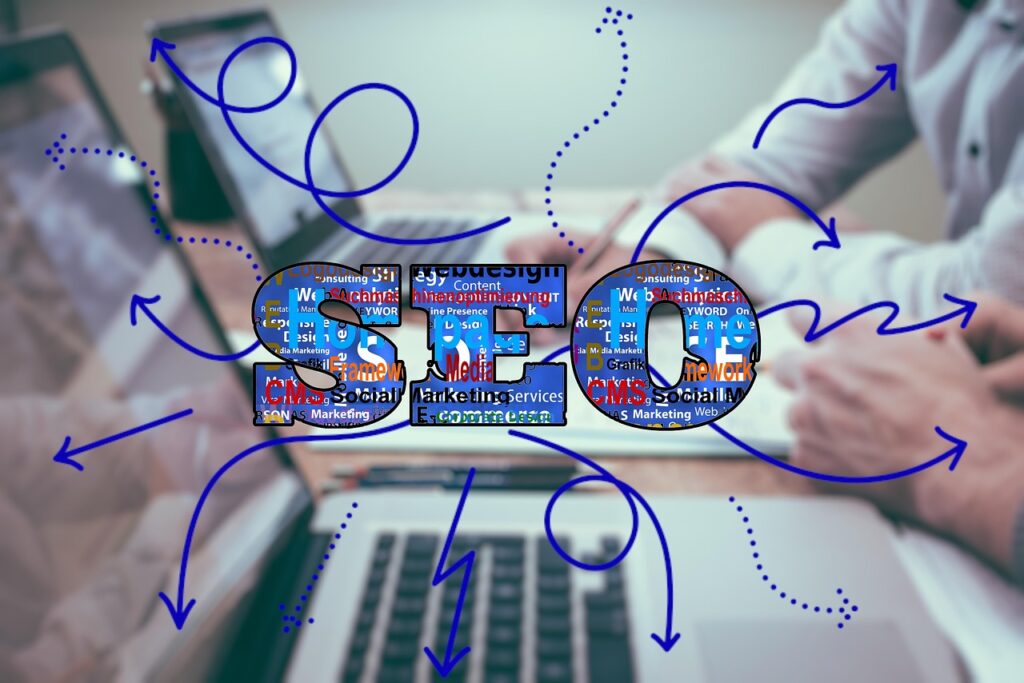
Master Web Pagination: Rank Better by Structuring Smarter
Web pagination doesn’t get much SEO love, but it should. Done right, it keeps your site lean, crawlable, and fast. Done wrong? It burns your crawl budget, confuses bots, and tanks performance. Here’s how to make pagination your silent ranking ally, not a liability.
🔍 What Is Web Pagination (and Where You See It Daily)
Pagination is the art of breaking up long lists into clean, navigable chunks. Think product pages on an e-commerce site. Blog archives split into page 1, 2, 3. Category pages that span dozens of entries.
If you’ve ever clicked a “Next” button or jumped from page 3 to 5 on a content list, you’ve used pagination. It’s not just UX fluff. When implemented well, it streamlines navigation for users and keeps search engines from choking on bloated pages.
📈 Is Pagination Good for SEO?
Yes — if you do it right.
Good pagination improves crawlability, speeds up load times, and makes your content easier to index. Google doesn’t want to dig through a single 100-item mega page. Breaking content into smaller, faster-loading pieces can improve discoverability and user behavior signals, both critical for rankings.
But bad pagination? That’s where things go south:
- 💥 Duplicate content from repeated elements across pages
- 🔁 Cannibalized ranking signals across near-identical URLs
- 🕳 Burned crawl budget on low-value or orphaned pages
Speaking of which…
🧠 Crawl Budget: Why Pagination Can Eat It Alive
Crawl budget = how many pages Googlebot wants and can crawl on your site within a timeframe. Paginated pages multiply your URLs fast. Without structure, Google could waste its time indexing “page 16” of your blog instead of your money page.
Here’s how to control the chaos:
- 🚫 Block deep, low-value pagination in robots.txt (but don’t go overboard, avoid blocking useful content)
- 🗺 Keep your XML sitemap sharp, only include index-worthy URLs
- ⚠️ Avoid creating crawl traps by linking endlessly between thin pagination pages
🧭 Pagination Isn’t Optional — Strategy Is
Pagination isn’t a problem. Poor pagination is. If your pages load fast, keep content unique, and are easy for crawlers to navigate, you’re doing it right.
Audit how you structure large sets of content. Prioritize crawl efficiency. And always, always map out how pagination impacts your site hierarchy, internal links, and indexing flow.
Master this technical detail, and you’ll give your SEO an invisible but powerful edge.
🤖 How Google Handles Pagination (Now That rel=prev/next Is Dead)
Once upon a time, Google told SEOs to use rel=”prev” and rel=”next” to help bots understand paginated content. That advice? Outdated. As of 2019, Google dropped support for those tags entirely.

So what now?
Google’s smarter, but not psychic. It no longer relies on rel tags to detect pagination. Instead, it pieces together pagination context from internal linking patterns and URL structure. That means it’s on you to show the relationship between pages clearly.
Here’s how to do it right:
- 🔗 Use standard <a href> links between pages — “Next,” “Previous,” and numbered buttons still work
- 🧭 Link back to page one from every page in the series — not just forward and backward
- 🆔 Use consistent URL patterns (e.g., ?page=2, ?page=3) — each page must have its own indexable URL
Google doesn’t need special markup, but it does need clarity. Give each paginated page a unique address, clean links, and a logical path, and it’ll connect the dots just fine.
Pro tip: It’s totally fine to reuse meta titles and descriptions across the series, as long as the body content stays distinct.
🔄 Pagination vs. Infinite Scroll: Which One Wins (and When)?
Pagination isn’t your only option, but it’s still the SEO favorite for a reason.
Both pagination and infinite scroll aim to break up large datasets into digestible chunks. But when it comes to SEO? Pagination wins more often because it creates clean, crawlable URLs for each segment. That means Google can index everything page by page, no special tricks required.
Infinite scroll, on the other hand, might feel slick, but it’s a minefield if not built right. Users love the seamless experience (sometimes). But search engines? Not so much, unless you go the extra mile.
🧱 Infinite Scroll Done Right (or Not at All)
If you’re going infinite, you need to treat SEO as a core feature, not an afterthought.
That means:
- Use progressive enhancement — load core content without relying entirely on JavaScript
- Include crawlable anchor links or pagination fallbacks for bots and users with JS disabled
- Maintain unique URLs for scrolled content states using pushState/history APIs
Miss one of these steps, and Google might skip entire chunks of your content.
🧩 Smart Alternatives to Pagination
Not sold on either? You’ve got a couple of hybrid options worth considering.
1. “View All” Button
- 🟢 Pro: Gives users and crawlers full access to the entire dataset
- 🔴 Con: Can wreck performance on large content sets (slow load, bad UX)
Use it only if your full dataset is light enough to load fast, or risk overwhelming both browsers and bots.
2. “Load More” Button
- Pro: Offers better UX than pagination, and cleaner indexing than infinite scroll
- Neutral: Loads in chunks, reducing performance strain
- Con: Needs technical finesse — each state should create a unique, indexable URL
If done right, “Load More” strikes a solid balance between crawlability and modern UX. But sloppy implementation? That’s SEO trouble waiting to happen.
⚖️ SEO Still Favors Pagination
Until infinite scroll and dynamic loading methods get easier for search engines to parse, static pagination remains the most reliable choice for structured content. Want to test alternatives? Cool, just be sure to build for both humans and crawlers from the start.
🧠SEO-Friendly Pagination Strategies That Actually Work
Want pagination to boost rankings instead of tank them? Then stop treating it like an afterthought. Smart pagination sends the right signals to search engines, avoids duplicate content traps, and keeps users moving through your site without friction.

Here’s how to structure it like a pro.
🏷 Canonical Tags
Canonical tags keep pagination from tripping over itself. If each page in your series has unique content, let it stand on its own, use a self-referencing canonical.
But if you’re dealing with filtered lists or near-duplicate versions, point everything back to the main category page. That tells Google where the real value lives and stops your signals from getting split across a dozen lookalike URLs.
It also helps clean up the mess when session IDs, sort parameters, or tracking tags start bloating your index. Don’t overthink it. Just show Google the version that matters most.
🧭 Navigation (Adding First/Last Page)
Pagination isn’t just “next” and “previous.” Add links to the first and last pages in every series, it gives Google a full map and users a faster way to jump around.
If page 20 is buried and there’s no shortcut, Google might never get there. Linking back to the beginning and ahead to the end helps flatten your crawl depth and tighten your internal linking.
It’s a simple structure boost that makes your content easier to index and way smoother to navigate. Use real anchor text, not mystery arrows. Help Google connect the dots faster.
🎯 Optimizing the First Paginated Page
Page one is the power page. If your pagination series ranks anywhere, it’s probably here, so treat it like a landing page, not just the start of a list.
This is where you drop the most useful content, hit your primary keyword, and show Google why this page deserves to show up in the results. That means unique body content, clean structure, and a sharp intro that doesn’t get recycled across the rest of the series.
If you’re using category descriptions, keep them exclusive to page one. Copy-pasting that block across every page in the series just dilutes the signal and clutters your crawl. One strong subpage beats ten weak clones.
Your meta title and description? Dialed in. Make them accurate, clickable, and keyword-aligned. There’s no need to change them across deeper paginated URLs, Google’s fine with duplicates there. Even John Mueller said so.
But if your SEO tool throws warnings about repetitive H1s? Back them off on pages 2 and beyond. One top-optimized page is enough, don’t confuse bots by overdoing it.
And don’t forget internal links. Use page one to feed authority to other key pages on your site. It’s the gateway. Make sure it pulls weight.
🔗 Using Crawlable Anchor Links and Clear URLs
If Google can’t crawl your pagination, it won’t index what’s behind it, simple as that. Your pagination needs to use clean, crawlable anchor links that tell search engines exactly where to go.
Skip the messy query strings. URLs like /page/2, /page/3, and so on are easier for crawlers to process, and they give structure to your content without relying on guesswork. Complex parameters with tracking IDs, sort orders, or AJAX fragments? That’s how crawl efficiency tanks fast.
Use standard <a> tags for all your pagination links. Label them clearly with real anchor text, “Next Page,” “Previous Page,” or page numbers. Don’t wrap your pagination in JavaScript-only behavior and expect Google to figure it out. If your links disappear when JavaScript is disabled, you’ve already lost the crawl.
JavaScript can make the UX slicker, sure, but your core functionality needs to work without it. Test your pagination with Google Search Console or URL Inspection. If crawlers can’t see it, neither will your audience.
🚫 Common Pagination Mistakes That Wreck SEO
Pagination should help your site scale, not sabotage it. But most setups include silent errors that waste crawl budget, confuse Google, and weaken your rankings. If your paginated content isn’t performing, it’s probably because of one of these avoidable mistakes.
- Misusing canonical tags – Pointing every paginated page back to page one is a signal killer. If each page has unique content, it should be canonical to itself, not the first in the series. Otherwise, you’re telling Google to ignore perfectly valuable pages for no good reason.
- Poor URL structure – Pagination URLs need to be simple and consistent. Skip the tracking IDs, filter strings, and bloated query parameters. Stick with clean formats like /page/2 or ?page=3. If your URLs look like gibberish, Google’s less likely to follow them cleanly.
- Missing navigation links – If your pagination doesn’t link to the first and last pages, you’re making Google guess where the ends are. That weakens crawl flow and hurts usability. Every page in the series should offer a complete path forward and back, not just one step at a time.
- Skipping mobile optimization – If your pagination breaks on mobile, you’re done. Google’s crawling mobile-first. Tap targets that are too small, or pagination that only works with JavaScript, block discoverability. Test everything in Lighthouse and fix mobile bugs fast.
- Publishing thin content – Paginated pages with almost no unique content aren’t helping you rank, they’re just clutter. If page three is five sentences and a repeated template, it’s dead weight. Combine weak pages, expand the content, or remove them entirely.
- Allowing multiple URLs for page one – Letting both /category and /category?p=1 serve the same page splits your equity. Fix it with a 301 redirect to the clean version, or lock in a canonical. Two URLs for the same page just confuses crawlers and waters down your rankings.
- Using canonical and noindex together – This is the classic conflict. Canonical says “index this version.” Noindex says “don’t.” Put both on a page and Google shrugs. Choose one: either guide what gets indexed, or tell it to stay out, but don’t send both signals at once.
🧭 Factors to Consider When Deciding on Pagination Pages
Pagination isn’t one-size-fits-all. If you want it to work for SEO and users, you’ve got to plan it around your actual content, audience behavior, and site structure. Here’s what to think through before pushing it live.
Content Length
Each page in your sequence needs to offer real value. If the content is too thin, Google may ignore it. If it’s too long, users will bounce.
The goal is to provide enough content to satisfy intent without overwhelming people with a wall of text. Use analytics to see how far users scroll, where they drop off, and what actually keeps them engaged. Then adjust accordingly.
User Experience
Pagination should make navigation easier, not harder. If users struggle to find “Next” or can’t tap through on mobile, you’re losing them.
Use clear, standard labels and keep the design clean, responsive, and intuitive. Mobile-first isn’t optional anymore. Test your pagination layout on real devices and make sure every interaction feels natural.
SEO Impact
How you build your pagination directly affects how well Google can crawl and index it. Clean URLs, fast load times, and clear structure all make it easier for bots to follow the path.
If your pagination setup slows things down or creates ambiguous linking patterns, your crawl efficiency takes a hit. Use clean code, minimize bloat, and always think a few steps ahead, every technical detail counts.
🕵️ How to Find Pagination Issues
If your pagination’s broken, buried, or bloated, it won’t fix itself. And if Google can’t crawl it cleanly, your content might as well not exist. Here’s how to catch problems before they wreck your rankings.
Google Search Console
Start with GSC. It shows you how Google sees your paginated pages, or doesn’t. Use the Coverage report to spot indexing gaps, and run the URL Inspection tool to see if key paginated URLs are actually crawlable. If something’s blocked, redirected, or missing, this is where you catch it.
Screaming Frog & Auditing Tools
Crawl your site with Screaming Frog, SEMrush, or Ahrefs. Look for thin content, duplicate tags, bad canonicals, or broken pagination links. Check the crawl depth, if your paginated pages are stuck four or five clicks deep, there’s a crawlability problem. Clean structure wins every time.
Web Analytics
Bounce rates don’t lie. If paginated content is leaking users, you’ll see it in Google Analytics. Use the Navigation Summary to see how people move through your sequence. If they drop off early or never reach later pages, your pagination isn’t doing its job. Track behavior, find friction, fix flow.
✅ Final Tips for Mastering Pagination
Pagination isn’t a one-time setup, it’s something you check, fix, and tune as your site evolves. Test it often. Run crawls. Make sure nothing silently broke while you weren’t looking.
Double-check that no paginated page is carrying both a canonical tag and a noindex. That combo kills your indexability. Pick a direction and signal it clearly, don’t send mixed messages.
Analytics tells you how real people interact with your pagination. If they aren’t clicking through, the structure isn’t working. Watch bounce rates. Track click paths. If page two is a ghost town, something’s off.
Stay sharp on SEO updates. Google doesn’t treat pagination the same way it did five years ago, and it won’t treat it the same way next year. Watch for shifts and adapt fast.
If it makes sense, add structured data. Marking up your paginated content with schema can help search engines understand context and relationships. It might even earn you rich snippets, and extra visibility in the SERPs.
That’s it. Pagination done right helps bots crawl, users convert, and rankings stick. Clean it up, test it often, and let every page in the series do its job.





